The dual frequency ultrasonic cleaner market is likely to grow from USD 753.2 million in 2025 and grow to USD 1,718.6 million by 2035, reflecting a compound annual growth rate (CAGR) of 8.6%. This growth is driven by the increasing adoption of ultrasonic cleaning technology in healthcare, electronics, automotive, and precision engineering industries. Dual frequency systems offer superior cleaning efficiency, reduced cycle time, and better adaptability to varied cleaning requirements compared with single-frequency units. Rising demand for high-precision cleaning in laboratories, surgical instruments, and industrial components is further fueling market expansion. The market trajectory indicates that dual frequency ultrasonic cleaners will play a critical role in enhancing operational efficiency, ensuring product quality, and supporting sustainability across diverse industrial and healthcare applications.
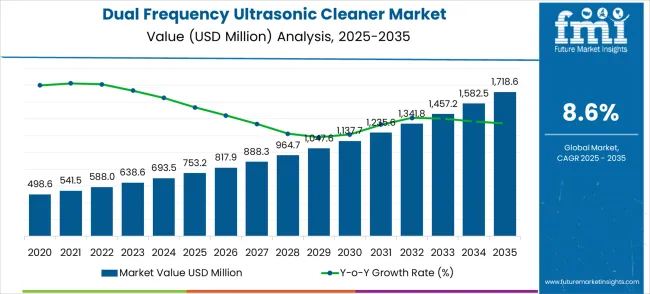
| Metric | Value |
|---|---|
| Estimated Value in (2025E) | USD 753.2 million |
| Forecast Value in (2035F) | USD 1,718.6 million |
| Forecast CAGR (2025 to 2035) | 8.6% |
A major factor influencing growth is the increasing emphasis on precision cleaning and equipment longevity. Year-on-year (YoY) growth shows a steady upward trend, with market values rising from USD 498.6 million in 2023 to USD 753.2 million in 2025, and continuing to increase consistently over the forecast period. Dual frequency ultrasonic cleaners provide enhanced cavitation control and the ability to clean complex surfaces without damage, making them highly desirable in sensitive applications. Strategic collaborations between equipment manufacturers and end-users are accelerating adoption, while advancements in energy efficiency, automation, and compact design make these systems more accessible. The growing importance of contamination control and maintenance efficiency across industries supports sustained market momentum.
Looking forward, the dual frequency ultrasonic cleaner market is expected to maintain strong growth, with market values reaching USD 1,137.7 million by 2030 and eventually USD 1,718.6 million by 2035, reflecting a CAGR of 8.6%. Analysis of the acceleration and deceleration pattern suggests periods of faster adoption in response to technological advancements, regulatory compliance needs, and increasing industrial automation. As industries increasingly require high-precision cleaning solutions, the demand for dual frequency ultrasonic cleaners will rise sharply. Continuous innovations in dual-frequency technology, improved operational efficiency, and integration with automated systems will further accelerate market penetration.
Market expansion is being supported by the increasing global demand for precision cleaning solutions and the corresponding need for advanced cleaning technologies that can maintain superior contamination removal while providing consistent performance across various industrial and laboratory applications. Modern manufacturing facilities are increasingly focused on implementing cleaning solutions that can deliver exceptional cleaning effectiveness, minimize particle contamination, and provide reliable results in critical manufacturing processes. Dual frequency ultrasonic cleaners' proven ability to provide superior cleaning performance, enhanced cavitation effects, and versatile frequency combinations make them essential equipment for contemporary semiconductor fabrication and medical device manufacturing applications.
The growing emphasis on manufacturing quality control and contamination prevention is driving demand for dual-frequency ultrasonic cleaners that can support advanced cleaning processes, enable consistent results, and reduce production defects through enhanced cleaning capabilities. Industrial manufacturers' preference for equipment that combines cleaning effectiveness with operational reliability and process optimization is creating opportunities for innovative cleaning technology implementations. The rising influence of miniaturization trends and precision manufacturing demands is also contributing to increased adoption of dual-frequency cleaners that can provide superior cleaning solutions without compromising component integrity or manufacturing quality.
The market is segmented by operating frequency, application, and region. By operating frequency, the market is divided into 28kHz/40kHz, 40kHz/80kHz, and others. Based on application, the market is categorized into semiconductor, medical, and industrial production. Regionally, the market is divided into North America, Europe, East Asia, South Asia & Pacific, Latin America, and the Middle East & Africa.
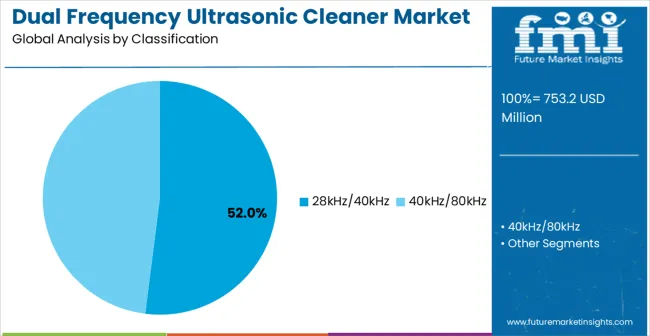
The 28kHz/40kHz segment is projected to account for 52.0% of the dual frequency ultrasonic cleaner market in 2025, reaffirming its position as the leading operating frequency category. Manufacturing facilities increasingly utilize 28kHz/40kHz dual frequency cleaners for their optimal balance of cleaning power and precision, providing effective contamination removal across various component sizes and materials in semiconductor and medical device applications. This frequency combination's proven cleaning effectiveness and widespread compatibility directly address the industrial requirements for reliable cleaning performance and operational efficiency in large-scale manufacturing operations.
This operating frequency segment forms the foundation of modern precision cleaning operations, as it represents the frequency combination with the greatest versatility and established market demand across multiple industrial sectors and cleaning applications. Manufacturer investments in enhanced frequency control technologies and transducer optimization continue to strengthen adoption among industrial facilities. With manufacturing companies prioritizing cleaning effectiveness and process reliability, 28kHz/40kHz dual frequency systems align with both operational efficiency objectives and quality assurance requirements, making them the central component of comprehensive cleaning strategies.
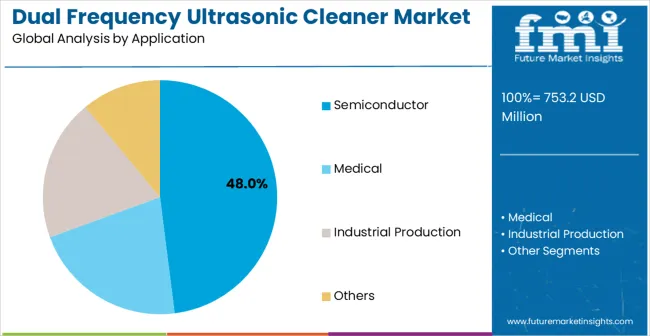
Semiconductor manufacturers are projected to represent 48.0% of dual-frequency ultrasonic cleaner demand in 2025, underscoring their critical role as the primary consumers of advanced cleaning equipment for wafer processing and component manufacturing applications. Semiconductor fabrication facilities prefer dual-frequency cleaners for their exceptional contamination removal capabilities, precise cleaning control, and ability to enhance manufacturing yield while reducing defect rates and process complexity. Positioned as essential equipment for modern semiconductor manufacturing, dual-frequency ultrasonic cleaners offer both cleaning advantages and productivity benefits.
The segment is supported by continuous innovation in semiconductor manufacturing technologies and the growing availability of specialized cleaning solutions that enable advanced contamination control with enhanced process monitoring capabilities. Semiconductor manufacturers are investing in automated cleaning systems to support high-volume production and consistent quality assurance. As semiconductor device complexity becomes more demanding and miniaturization requirements increase, semiconductor manufacturers will continue to dominate the application market while supporting advanced cleaning technology utilization and process optimization strategies.
The dual-frequency ultrasonic cleaner market is advancing rapidly due to increasing semiconductor manufacturing complexity and growing demand for precision cleaning solutions that provide enhanced contamination removal and superior cleaning effectiveness across diverse industrial applications. However, the market faces challenges, including high equipment costs, complex frequency optimization requirements, and the need for specialized training and maintenance expertise. Innovation in frequency control technologies and automated cleaning systems continues to influence product development and market expansion patterns.
The growing adoption of sophisticated frequency modulation and intelligent control systems is enabling cleaner manufacturers to produce high-performance dual-frequency equipment with superior cleaning effectiveness, enhanced process control, and optimized energy efficiency. Advanced frequency control systems provide improved cleaning results while allowing more precise process optimization and consistent performance across various cleaning applications. Manufacturers are increasingly recognizing the competitive advantages of advanced frequency technologies for product differentiation and premium market positioning.
Modern dual-frequency ultrasonic cleaner producers are incorporating intelligent process control and automated monitoring systems to enhance cleaning consistency, optimize process parameters, and ensure reliable performance delivery across various industrial applications. These technologies improve manufacturing efficiency while enabling new capabilities, including real-time process monitoring and predictive maintenance functionality. Advanced automation integration also allows manufacturers to support premium product positioning and enhanced operational efficiency beyond traditional manual cleaning processes.
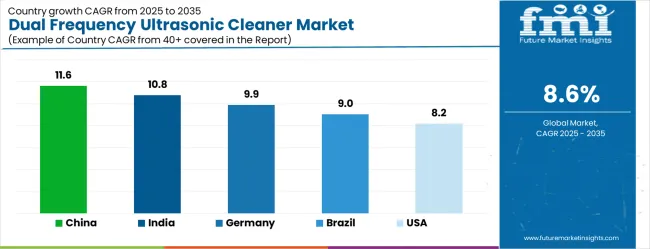
| Country | CAGR (2025-2035) |
|---|---|
| China | 11.6% |
| India | 10.8% |
| Germany | 9.9% |
| Brazil | 9.0% |
| USA | 8.2% |
| UK | 7.3% |
| Japan | 6.5% |
The dual frequency ultrasonic cleaner market is experiencing strong growth globally, with China leading at an 11.6% CAGR through 2035, driven by the expanding semiconductor manufacturing industry, growing electronics production capabilities, and significant investment in advanced manufacturing infrastructure development. India follows at 10.8%, supported by large-scale industrial development, advancing manufacturing automation facilities, and growing domestic demand for precision cleaning equipment. Germany shows growth at 9.9%, emphasizing technological innovation and premium cleaning equipment development. Brazil records 9.0%, focusing on industrial manufacturing expansion and technology modernization programs. The USA demonstrates 8.2% growth, prioritizing advanced semiconductor technologies and medical device manufacturing applications. The UK exhibits 7.3% growth, with a focus on precision manufacturing and industrial automation applications. Japan shows 6.5% growth, supported by advanced electronics manufacturing and precision cleaning technology innovation.
The report covers an in-depth analysis of 40+ countries top-performing countries are highlighted below.
Revenue from dual-frequency ultrasonic cleaners in China is projected to exhibit exceptional growth with a CAGR of 11.6% through 2035, driven by expanding semiconductor manufacturing infrastructure and rapidly growing electronics production capabilities supported by government advanced manufacturing initiatives. The country's massive semiconductor fabrication capacity and increasing investment in precision cleaning technologies are creating substantial demand for advanced cleaning equipment solutions. Major semiconductor manufacturers and electronics producers are establishing comprehensive cleaning capabilities to serve both domestic and international markets.
Revenue from dual-frequency ultrasonic cleaners in India is expanding at a CAGR of 10.8%, supported by the country's growing industrial manufacturing capacity, advancing technology infrastructure, and increasing domestic demand for precision cleaning solutions in electronics and medical device production. The country's comprehensive industrial development programs and expanding manufacturing sector are driving demand for sophisticated cleaning capabilities. International technology providers and domestic manufacturers are establishing extensive production and distribution capabilities to address the growing demand for industrial cleaning equipment.
Revenue from dual-frequency ultrasonic cleaners in Germany is expanding at a CAGR of 9.9%, supported by the country's advanced precision manufacturing sector, strong emphasis on industrial automation, and robust demand for high-quality cleaning solutions among technology-focused manufacturers. The nation's mature industrial equipment industry and commitment to advanced manufacturing technologies are driving sophisticated cleaning equipment integration throughout manufacturing operations. Leading technology companies and equipment manufacturers are investing extensively in premium product development and advanced cleaning technologies to serve both domestic and export markets.
Revenue from dual-frequency ultrasonic cleaners in Brazil is growing at a CAGR of 9.0%, driven by expanding industrial manufacturing infrastructure, increasing technology adoption in production facilities, and growing investment in manufacturing modernization programs. The country's developing industrial sector and modernization of manufacturing facilities are supporting demand for advanced cleaning technologies across major industrial regions. Manufacturing companies and industrial equipment producers are establishing comprehensive capabilities to serve both domestic markets and regional export opportunities.
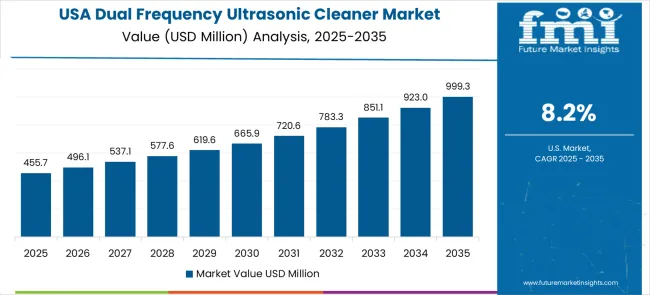
Revenue from dual-frequency ultrasonic cleaners in the USA is expanding at a CAGR of 8.2%, supported by the country's advanced semiconductor industry, strong emphasis on medical device manufacturing, and strategic focus on precision cleaning technology development. The USA's established electronics manufacturing sector and leadership in semiconductor technology are driving demand for specialized cleaning equipment focusing on high-performance applications and premium product development. Manufacturers are investing in comprehensive research and development facilities to serve both domestic and international markets with innovative cleaning solutions.
Revenue from dual-frequency ultrasonic cleaners in the UK is growing at a CAGR of 7.3%, driven by the country's advancing precision manufacturing sector, emphasis on industrial automation technologies, and strong demand for quality cleaning solutions in aerospace and medical applications. The UK's established engineering industry and commitment to advanced manufacturing development are supporting investment in sophisticated cleaning capabilities throughout major industrial centers. Industry leaders are establishing comprehensive technology development programs to serve both domestic and European markets with advanced cleaning equipment.
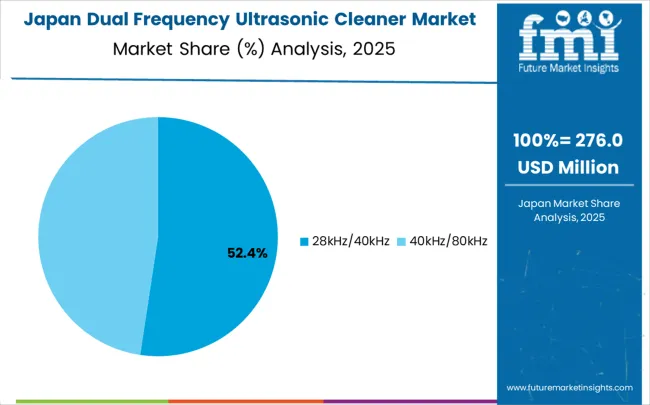
Revenue from dual-frequency ultrasonic cleaners in Japan is expanding at a CAGR of 6.5%, supported by the country's focus on advanced electronics manufacturing, precision cleaning technology development, and strong emphasis on manufacturing quality control systems. Japan's sophisticated electronics industry and commitment to technological innovation are driving demand for advanced cleaning technologies, including miniaturized cleaning systems and high-precision solutions for removing contamination. Leading technology companies are investing in specialized capabilities to serve semiconductor fabrication, precision components, and medical device segments with premium cleaning equipment.
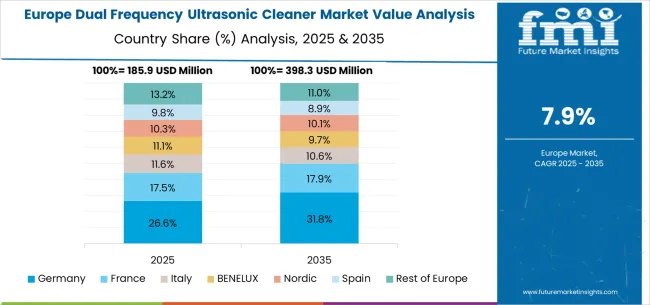
The dual frequency ultrasonic cleaner market in Europe is projected to grow from USD 165.7 million in 2025 to USD 378.1 million by 2035, registering a CAGR of 8.6% over the forecast period. Germany is expected to maintain its leadership position with a 35.0% market share in 2025, declining slightly to 34.5% by 2035, supported by its strong precision manufacturing sector, advanced industrial automation facilities, and comprehensive cleaning equipment technology supply network serving major European markets.
France follows with a 17.0% share in 2025, projected to reach 17.5% by 2035, driven by robust demand for cleaning equipment in aerospace manufacturing, automotive electronics production, and medical device applications, combined with established engineering traditions incorporating advanced cleaning technologies. The United Kingdom holds a 14.0% share in 2025, expected to decrease to 13.5% by 2035, supported by strong precision manufacturing demand but facing challenges from supply chain adjustments and competitive pressures from continental suppliers. Italy commands an 11.0% share in 2025, projected to reach 11.2% by 2035, while Spain accounts for 8.0% in 2025, expected to reach 8.3% by 2035. The Netherlands maintains a 4.5% share in 2025, growing to 4.7% by 2035. The Rest of Europe region, including Nordic countries, Eastern Europe, Portugal, Belgium, Switzerland, and Austria, is anticipated to gain momentum, expanding its collective share from 10.5% to 10.3% by 2035, attributed to increasing adoption of advanced manufacturing technologies in Nordic countries and growing electronics production activities across Eastern European markets implementing industrial modernization programs.
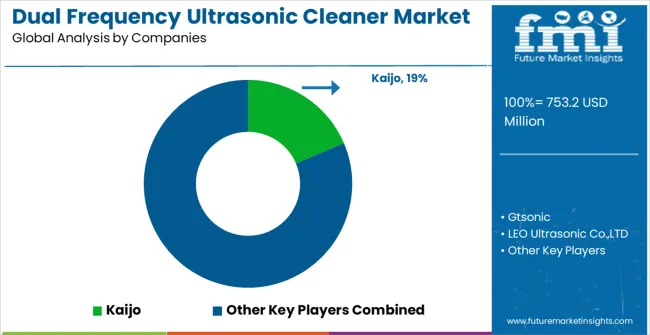
The dual-frequency ultrasonic cleaner market is characterized by competition among established cleaning equipment manufacturers, specialized ultrasonic technology providers, and integrated industrial equipment producers. Companies are investing in advanced frequency control research, manufacturing process optimization, intelligent control systems, and comprehensive product portfolios to deliver consistent, high-performance, and cost-effective cleaning solutions. Innovation in frequency modulation technologies, automated cleaning systems, and specialized application development is central to strengthening market position and competitive advantage.
Kaijo leads the market with a strong market share, offering comprehensive ultrasonic cleaning solutions with a focus on semiconductor and precision manufacturing applications. Gtsonic provides specialized cleaning equipment manufacturing capabilities with an emphasis on dual frequency technology and custom solutions. LEO Ultrasonic Co., LTD delivers innovative cleaning systems with a focus on industrial automation and process optimization. Labmate specializes in laboratory and industrial cleaning equipment for research and production applications. Scientz focuses on advanced ultrasonic technologies and precision cleaning solutions. LABOAO offers specialized cleaning equipment with emphasis on laboratory and research applications.
The dual frequency ultrasonic cleaner market, valued at USD 753.2 million in 2025 and projected to reach USD 1,718.6 million by 2035 at an 8.6% CAGR, represents a critical technology segment within precision manufacturing and industrial cleaning. Driven by semiconductor manufacturing complexity, medical device production demands, and industrial contamination control requirements, the market faces challenges including high equipment costs, technical expertise requirements, and complex frequency optimization needs. Success requires coordinated efforts across technology developers, equipment manufacturers, semiconductor fabricators, medical device producers, and industrial automation specialists.
How Governments Could Accelerate Technology Adoption and Manufacturing Competitiveness?
How Industry Associations Could Strengthen Technology Standards and Market Development?
How Equipment Manufacturers and Technology Developers Could Drive Innovation?
How End-User Industries Could Optimize Technology Implementation?
How Investors and Financial Enablers Could Support Market Expansion?
| Items | Values |
|---|---|
| Quantitative Units (2025) | USD 753.2 million |
| Operating Frequency | 28kHz/40kHz, 40kHz/80kHz, Others |
| Application | Semiconductor, Medical, Industrial Production |
| Regions Covered | North America, Europe, East Asia, South Asia & Pacific, Latin America, Middle East & Africa |
| Countries Covered | United States, Canada, United Kingdom, Germany, France, China, Japan, South Korea, India, Brazil, Australia and 40+ countries |
| Key Companies Profiled | Kaijo, Gtsonic, LEO Ultrasonic Co., LTD, Labmate, Scientz, and LABOAO |
| Additional Attributes | Dollar sales by operating frequency and application category, regional demand trends, competitive landscape, technological advancements in frequency control systems, automated cleaning innovation, process optimization integration, and supply chain optimization |
The dual frequency ultrasonic cleaner market is estimated to be valued at USD 753.2 million in 2025.
The market size for the dual frequency ultrasonic cleaner market is projected to reach USD 1,718.6 million by 2035.
The dual frequency ultrasonic cleaner market is expected to grow at a 8.6% CAGR between 2025 and 2035.
The key product types in dual frequency ultrasonic cleaner market are 28khz/40khz and 40khz/80khz.
In terms of application, semiconductor segment to command 48.0% share in the dual frequency ultrasonic cleaner market in 2025.






Our Research Products

The "Full Research Suite" delivers actionable market intel, deep dives on markets or technologies, so clients act faster, cut risk, and unlock growth.

The Leaderboard benchmarks and ranks top vendors, classifying them as Established Leaders, Leading Challengers, or Disruptors & Challengers.

Locates where complements amplify value and substitutes erode it, forecasting net impact by horizon

We deliver granular, decision-grade intel: market sizing, 5-year forecasts, pricing, adoption, usage, revenue, and operational KPIs—plus competitor tracking, regulation, and value chains—across 60 countries broadly.

Spot the shifts before they hit your P&L. We track inflection points, adoption curves, pricing moves, and ecosystem plays to show where demand is heading, why it is changing, and what to do next across high-growth markets and disruptive tech

Real-time reads of user behavior. We track shifting priorities, perceptions of today’s and next-gen services, and provider experience, then pace how fast tech moves from trial to adoption, blending buyer, consumer, and channel inputs with social signals (#WhySwitch, #UX).

Partner with our analyst team to build a custom report designed around your business priorities. From analysing market trends to assessing competitors or crafting bespoke datasets, we tailor insights to your needs.
Supplier Intelligence
Discovery & Profiling
Capacity & Footprint
Performance & Risk
Compliance & Governance
Commercial Readiness
Who Supplies Whom
Scorecards & Shortlists
Playbooks & Docs
Category Intelligence
Definition & Scope
Demand & Use Cases
Cost Drivers
Market Structure
Supply Chain Map
Trade & Policy
Operating Norms
Deliverables
Buyer Intelligence
Account Basics
Spend & Scope
Procurement Model
Vendor Requirements
Terms & Policies
Entry Strategy
Pain Points & Triggers
Outputs
Pricing Analysis
Benchmarks
Trends
Should-Cost
Indexation
Landed Cost
Commercial Terms
Deliverables
Brand Analysis
Positioning & Value Prop
Share & Presence
Customer Evidence
Go-to-Market
Digital & Reputation
Compliance & Trust
KPIs & Gaps
Outputs
Full Research Suite comprises of:
Market outlook & trends analysis
Interviews & case studies
Strategic recommendations
Vendor profiles & capabilities analysis
5-year forecasts
8 regions and 60+ country-level data splits
Market segment data splits
12 months of continuous data updates
DELIVERED AS:
PDF EXCEL ONLINE
Dual-Channel Tactical Communication Headset Market Size and Share Forecast Outlook 2025 to 2035
Dual P-channel MOSFET Market Size and Share Forecast Outlook 2025 to 2035
Dual Wavelength Raman Probe Market Size and Share Forecast Outlook 2025 to 2035
Dual Wavelength Raman Spectrometer Market Size and Share Forecast Outlook 2025 to 2035
Dual Air Chamber Hydro-pneumatic Suspension Market Size and Share Forecast Outlook 2025 to 2035
DualMode Automated Tow Tractor Market Size and Share Forecast Outlook 2025 to 2035
Dual Clutch Transmission Market Size and Share Forecast Outlook 2025 to 2035
Dual-Cure Luting Cements Market Size and Share Forecast Outlook 2025 to 2035
Dual Screen Laptops Market Size and Share Forecast Outlook 2025 to 2035
Dual Ovenable Trays and Containers Market Size and Share Forecast Outlook 2025 to 2035
Dual Relay Board Market Size and Share Forecast Outlook 2025 to 2035
Dual Chamber Dispensing Bottles Market Size and Share Forecast Outlook 2025 to 2035
Dual Voltage Comparator Market Size and Share Forecast Outlook 2025 to 2035
Dual and Multi-Energy Computed Tomography (CT) Market Size and Share Forecast Outlook 2025 to 2035
Dual-Phase Cleanser Market Size and Share Forecast Outlook 2025 to 2035
The Dual Balloon Angioplasty Catheter Market is segmented by Peripheral, and Coronal from 2025 to 2035
Dual Biomarker Assays Market Analysis - Size, Share, & Forecast Outlook 2025 to 2035
Dual Flap Dispensing Closure Market Size & Trends 2025 to 2035
Dual Ovenable Lidding Films Market by Material, Seal Type, Application & Region - Forecast 2025 to 2035
Dual-Chamber Pumps Market Analysis - Size, Share, and Forecast Outlook (2025 to 2035)

Thank you!
You will receive an email from our Business Development Manager. Please be sure to check your SPAM/JUNK folder too.
Chat With
MaRIA